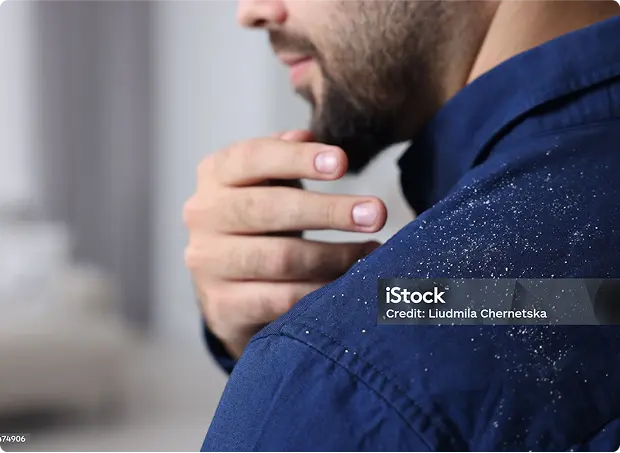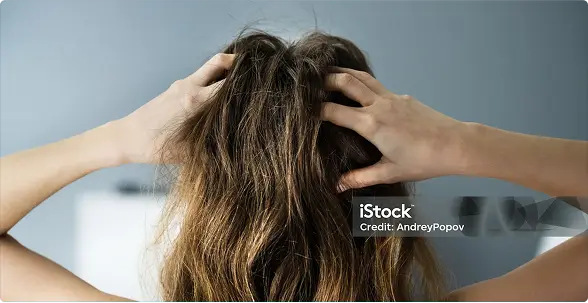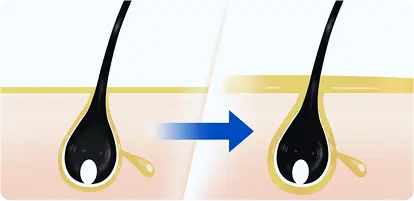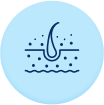- SCALP SCHOOL
Welcome to scalp school
Think of this as your go-to guide for understanding what’s really going on up top.
Whether you’re dealing with flakes, wondering what causes them, or just keen to learn the facts (and ditch the myths), you’re in the right place.
From what dandruff actually is, to the different types, root causes, and treatment options – we’re here to help you get smart about your scalp.
Ready to become a flake-fighting pro? Let’s get started.
- What is dandruff?
- The root cause
- Types of dandruff
- Dandruff quiz
- Scalp Myths & Facts
- FAQs
- PART 1
What is dandruff?
Dandruff is a common scalp concern caused by an overgrowth of a natural yeast on the skin, leading to flaking, itchiness, and irritation. You might notice white or yellow flakes, a dry or oily scalp, or redness. Triggers like stress, cold weather, or product build-up can make it worse — but the good news is, with the right treatment, it’s manageable.

- PART 2
Types of dandruff
Flakes can be sneaky,
they don’t all look or feel the same.
From dry and powdery to oily and stuck-on, dandruff can show up in a few different ways depending on your scalp type, lifestyle, and even how often you wash your hair.
Click through to see which type sounds most like you — and how to manage it.
Oily scalp flakes
Smaller, white flakes that often appear in winter or when the scalp is dry and irritated.

Dry scalp flakes
Smaller, white flakes that often appear in winter or when the scalp is dry and irritated.

Product-related flakes
Smaller, white flakes that often appear in winter or when the scalp is dry and irritated.

Persistent flakes
Smaller, white flakes that often appear in winter or when the scalp is dry and irritated.

- PART 3
Myths & Facts about dandruff
they don’t all look or feel the same.
MYTH 1
Dandruff is caused by poor hygiene.
Dandruff isn’t about being dirty — it’s often caused by a natural yeast on the scalp, not how often you wash your hair.
MYTH 2
You should stop washing your hair if you have flakes.
Regular washing with the right shampoo can actually help control dandruff and soothe your scalp.
MYTH 3
Dandruff only happens if you have dry skin.
Oily scalps can get dandruff too — in fact, excess oil can feed the yeast
that triggers flaking.
MYTH 4
You can catch dandruff from someone else.
Dandruff isn’t contagious!
You can’t catch it from a friend or partner.
MYTH 5
If flakes come back, the shampoo didn’t work.
Dandruff can recur over time. That’s why ongoing maintenance (like weekly use) can help keep it under control.
MYTH 6
Scratching your scalp helps get rid of flakes.
It might feel satisfying, but scratching can make irritation
worse and even damage the skin.
MYTH 1
Dandruff is caused by poor hygiene.
Dandruff isn’t about being dirty — it’s often caused by a natural yeast on the scalp, not how often you wash your hair.
MYTH 2
You should stop washing your hair if you have flakes.
Regular washing with the right shampoo can actually help control dandruff and soothe your scalp.
MYTH 3
Dandruff only happens if you have dry skin.
Oily scalps can get dandruff too — in fact, excess oil can feed the yeast that triggers flaking.
MYTH 4
You can catch dandruff from someone else.
Dandruff isn’t contagious! You can’t catch it from a friend or partner.
MYTH 5
If flakes come back, the shampoo didn’t work.
Dandruff can recur over time. That’s why ongoing maintenance (like weekly use) can help keep it under control.
MYTH 6
Scratching your scalp helps get rid of flakes.
It might feel satisfying, but scratching can make irritation worse and even damage the skin.
- PART 4
The root cause
For most people, dandruff starts when a natural yeast on the scalp gets out of balance. It’s totally normal for this yeast to live on our skin — but under certain conditions, it can grow too much and trigger flaking, irritation or itchiness.
A mix of factors like oil production, yeast imbalance, and scalp sensitivity can all contribute to the development of dandruff.

Malassezia spp. overgrowth
A naturally occurring yeast called Malassezia lives on everyone’s scalp. In some people, it can multiply more than usual — irritating the skin and contributing to dandruff.

Oil Gland Activity
When the scalp produces too much oil, it creates an environment where Malassezia can thrive. More oil = more yeast = more flakes.

Scalp sensitivity
Some people’s scalps are just more reactive. Factors like stress, skin health, genetics and nutrition can all play a role in how likely you are to experience dandruff.

Malassezia spp. overgrowth
A naturally occurring yeast called Malassezia lives on everyone’s scalp. In some people, it can multiply more than usual — irritating the skin and contributing to dandruff.

Oil Gland Activity
When the scalp produces too much oil, it creates an environment where Malassezia can thrive. More oil = more yeast = more flakes.

Scalp sensitivity
Some people’s scalps are just more reactive. Factors like stress, skin health, genetics and nutrition can all play a role in how likely you are to experience dandruff.
Other causes

Emotional stress
Stress can trigger oil production and throw your scalp off balance.

Nutrition
Low levels of certain B vitamins can affect scalp health.

Skin barrier health
A weak scalp barrier can make you more prone to flakes and irritation.

Nerve sensitivity
Changes in the nervous system may impact how your scalp reacts.

Genetics
Some people are naturally more sensitive to dandruff triggers.

Emotional stress
Stress can trigger oil production and throw your scalp off balance.

Nutrition
Low levels of certain B vitamins can affect scalp health.

Skin barrier health
A weak scalp barrier can make you more prone to flakes and irritation.

Nerve sensitivity
Changes in the nervous system may impact how your scalp reacts.

Genetics
Some people are naturally more sensitive to dandruff triggers.
- SCALP QUIZ
Is your scalp trying to tell you something?
Flakes, itching, and irritation can mean different things.
Take our quick scalp check to understand your symptoms and find the right solution for you.

Small & Light, occasional flakes

Noticeable flakes on hair and shoulders

Heavy flaking with redness or irritation
- SCALP QUIZ
How often do your symptoms appear?
How often is it happening for you?
- SCALP QUIZ
How is your scalp feeling?
Flakes are one thing – but how does your scalp
actually feel day to day?
- SCALP QUIZ
Nizoral 2%
Anti-Dandruff Shampoo
Targets severe dandruff and seborrhoeic
dermatitis for long-lasting relief.

Clinically proven – to be effective in ~9/10 users

Protects against persistent, recurring flakes8,9
Lorem ipsum dolor sit amet?
Lorem ipsum dolor sit amet, consectetur adipiscing elit. Sed do eiusmod tempor incididunt ut labore et dolore magna aliqua. Ut enim ad minim veniam, quis nostrud exercitation ullamco laboris nisi ut aliquip ex ea commodo consequat.
Lorem ipsum dolor sit amet?
Lorem ipsum dolor sit amet, consectetur adipiscing elit. Sed do eiusmod tempor incididunt ut labore et dolore magna aliqua. Ut enim ad minim veniam, quis nostrud exercitation ullamco laboris nisi ut aliquip ex ea commodo consequat.
Lorem ipsum dolor sit amet?
Lorem ipsum dolor sit amet, consectetur adipiscing elit. Sed do eiusmod tempor incididunt ut labore et dolore magna aliqua. Ut enim ad minim veniam, quis nostrud exercitation ullamco laboris nisi ut aliquip ex ea commodo consequat.
Lorem ipsum dolor sit amet?
Lorem ipsum dolor sit amet, consectetur adipiscing elit. Sed do eiusmod tempor incididunt ut labore et dolore magna aliqua. Ut enim ad minim veniam, quis nostrud exercitation ullamco laboris nisi ut aliquip ex ea commodo consequat.
Why is Nizoral the solution?
In adult apply a small amount of treatment to wet hair and scalp. Work into a lather and leave in contact for 3-5 minutes. Rinse thoroughly. Do this twice weekly.





